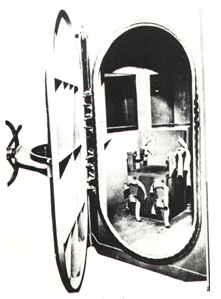The Executioner's Diary /
Methods / back /
next

Gas Chamber
"Doctor, will that gas in there bother my asthma?"
"Not for long!"
An exchange between the official doctor and Louis Jose Mongé
prior to his execution in 1967.
In 1924 Gee Jon, a Chinese immigrant in the USA, had the dubious honour of becoming
the first person to die in the gas chamber. The use of gas as a means of execution
was an attempt to execute a victim painlessly, and was first used in the state of Nevada, USA.
The modern gas chamber is an airtight structure built of steel, with windows installed to allow witnesses to watch the
proceedings. Inside the chamber there is a chair (or two in some chambers) to which the victim is strapped into. A stethescope tube is attached to the chest
and is led out of the chamber through an airtight opening through which the victim's heart is monitored by the doctor in attendence. A two-pound bag of Sodium Cyanide pellets are
suspended underneath the chair over a built-in container. Connected to the container is another tube leading into another jar/container in a room adjacent to the execution chamber
This room is usually called the mixing-room and is where the executioner is prior to the prisoner being brought in. Minutes before the victim enters the chamber,
the executioner fills the jar with a gallon mixture of distilled water and sulphuric acid. The executioner will then make a last minute check that
the chamber remains airtight. The prisoner is then brought into the chamber secured in the chair and connected to the stethescope tube. The chamber door is locked after
all officials have departed the chamber.
Now the process begins; the executioner turns on an exhaust fan to draw out some of the air in the chamber. Next he releases the sulphuric acid/distilled water mix through
the tube into the container beneath the chair. At a signal from the warden of the prison, the executioner pulls a lever which releases the suspended cyanide bag into
the sulphuric acid/distilled water mix. The cyanide dissolves in the mixture releasing pale cyanide gas fumes. As the victim inhales, the action of the cyanide gas inhibits the
respitory enzymes from transferring oxygen from the blood to the body cells, and death results through asphyxiation.
